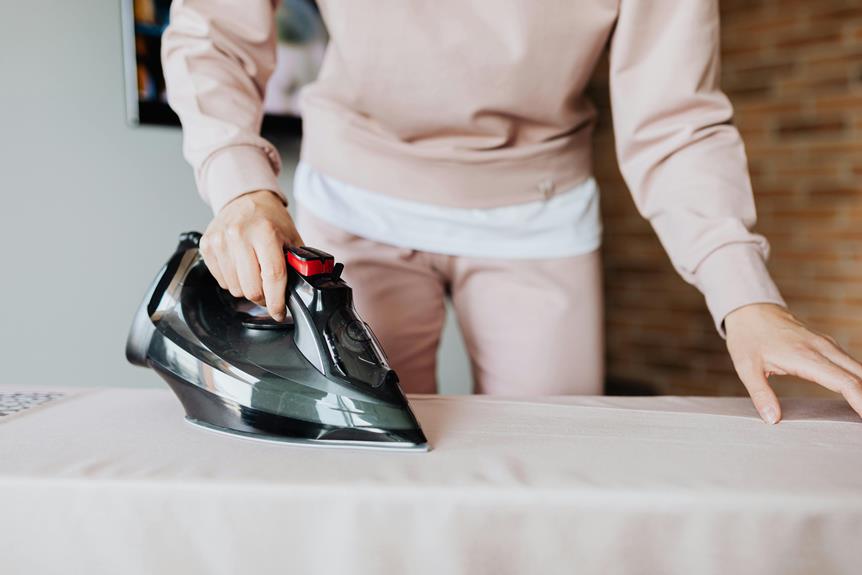When you're tackling delicate fabrics, it's crucial to adjust your iron settings to avoid any unwanted creasing. Start by ensuring you've got the right temperature dialed in—each fabric type requires a specific approach. Using a pressing cloth can further safeguard against damage, and don't forget to iron on the reverse side for extra protection. But that's just the beginning. The technique you employ can make all the difference, and understanding how moisture plays a role could change your ironing game entirely. Curious about the best methods to achieve that flawless finish?
Table of Contents
Key Takeaways
- Always check care labels for appropriate temperature settings to prevent damage to delicate fabrics.
- Use a pressing cloth to protect the fabric from direct heat and avoid scorching.
- Iron on the reverse side of the fabric to minimize the risk of shiny marks.
- Keep the fabric slightly moist by misting with water or using the steam function on the iron.
Choose the Right Iron Settings
To protect delicate fabrics, always adjust your iron to the appropriate settings based on the material. Different fabrics require different heat levels, and using the wrong setting can lead to burns or damage.
For silk and chiffon, set your iron to a low temperature, usually around 250°F. This gentle heat will help remove wrinkles without harming the fibers.
For delicate synthetics like polyester, use a medium setting. It's effective for smoothing out creases while minimizing the risk of melting the fabric. On the other hand, if you're working with cotton blends, you can increase the heat slightly, but still be cautious.
Always check the care label for specific instructions regarding heat settings. If you're unsure, it's better to start with a lower setting and gradually increase it if necessary. You can always press a bit harder or longer, but you can't undo a burn.
Lastly, remember to keep the iron moving to avoid overheating any one spot. By taking the time to choose the right settings, you'll maintain the integrity of your delicate fabrics and keep them looking fresh and beautiful.
Use a Pressing Cloth
Using a pressing cloth can provide an extra layer of protection for delicate fabrics, ensuring they withstand the heat from your iron without damage.
A pressing cloth acts as a barrier between the iron and your fabric, preventing direct contact that could lead to scorching or shine.
Here are three tips for using a pressing cloth effectively:
- Choose the Right Material: Select a lightweight cotton or muslin cloth. These materials allow steam to pass through while providing sufficient protection from heat.
- Keep it Clean: Make sure your pressing cloth is free from stains or residues that could transfer onto your fabric. Wash it regularly to maintain its effectiveness.
- Position It Correctly: Lay the pressing cloth over the fabric you're ironing, ensuring it covers the entire area. This will evenly distribute the heat and prevent creasing.
Iron on Reverse Side
Ironing on the reverse side of delicate fabrics helps prevent damage and maintains the fabric's appearance. When you flip your garment inside out, you reduce the risk of leaving shiny marks or scorch marks on the front. This technique is especially important for fabrics like silk, chiffon, or lace, which can easily be damaged by direct heat.
Before you start, make sure the iron is set to the appropriate temperature for the fabric type. While you're ironing, keep the iron moving smoothly and avoid applying too much pressure. Instead, let the weight of the iron do the work. This way, you minimize the chances of stretching or distorting the fabric.
Be mindful of seams and embellishments, as they can create uneven surfaces that may cause unwanted creases. If you encounter any stubborn wrinkles, lift the iron slightly and use a gentle, gliding motion over the area until it smooths out.
Keep Fabric Moist
Keeping the fabric moist while ironing helps relax fibers and makes it easier to remove wrinkles without damaging delicate materials. Here are a few techniques to keep your fabric moist during the ironing process:
- Use a Spray Bottle: Lightly mist the fabric with water before you start ironing. This method allows you to control the moisture level, ensuring it doesn't become overly wet, which can ruin delicate fabrics.
- Steam Setting: If your iron has a steam function, use it! The steam helps hydrate the fibers, making them more pliable and easier to smooth out. Just ensure the steam isn't too intense to avoid scorching.
- Damp Cloth: Place a damp pressing cloth between the iron and the fabric. This provides a protective barrier while still allowing moisture to penetrate, helping to relax the fibers without direct heat exposure.
Employ Proper Ironing Technique
Employing the right ironing technique ensures you avoid damaging delicate fabrics while effectively removing wrinkles.
Start by setting your iron to the appropriate temperature for the fabric type—lower settings work best for silk, lace, and chiffon. Always use a pressing cloth, like a clean cotton or muslin, to create a barrier between the iron and the fabric. This helps prevent direct heat contact, reducing the risk of burns or shiny spots.
When ironing, use a gentle, gliding motion. Don't press down too hard; instead, let the weight of the iron do the work. Move from the center of the garment outward to avoid pushing wrinkles deeper into the fabric. If you encounter stubborn creases, try steaming rather than direct ironing, as it's less likely to harm delicate fibers.
Work in sections and keep the fabric taut but not stretched. Pay attention to seams, ruffles, and embellishments—use the tip of the iron and carefully maneuver around these areas.
Frequently Asked Questions
What Types of Delicate Fabrics Require Special Ironing Care?
When ironing, you'll find silk, chiffon, lace, and tulle require special care. These fabrics can easily get damaged or lose their shape, so it's essential to handle them gently and use appropriate settings.
Can I Use Steam on All Delicate Fabrics?
You can't use steam on all delicate fabrics. Some materials, like silk and chiffon, may get damaged. Always check the care label first to ensure steam won't harm your delicate items during ironing.
How Often Should I Clean My Iron for Delicate Fabrics?
You should clean your iron regularly, ideally after every few uses. This prevents residue buildup that can transfer onto delicate fabrics. A clean iron ensures your clothes stay pristine and free from unwanted marks or stains.
What Should I Do if My Fabric Gets Scorched?
If your fabric gets scorched, don't panic. First, cool the area with cold water. Next, sprinkle baking soda on the stain, let it sit, then gently scrub with a soft cloth to lift the scorch.
Are There Alternative Methods to Iron Delicate Fabrics?
Absolutely! You can steam your delicate fabrics instead of ironing. Hang them in the bathroom while you shower or use a handheld steamer. Just be gentle to avoid damaging the fibers or causing any creases.
- Tetron Fabric for Marine Applications: Durability and Use Cases - June 18, 2025
- Tetron Fabric for Outdoor Furniture: Weather Resistance and Care - June 18, 2025
- Tetron Fabric for Wall Coverings: Style and Application Tips - June 18, 2025







